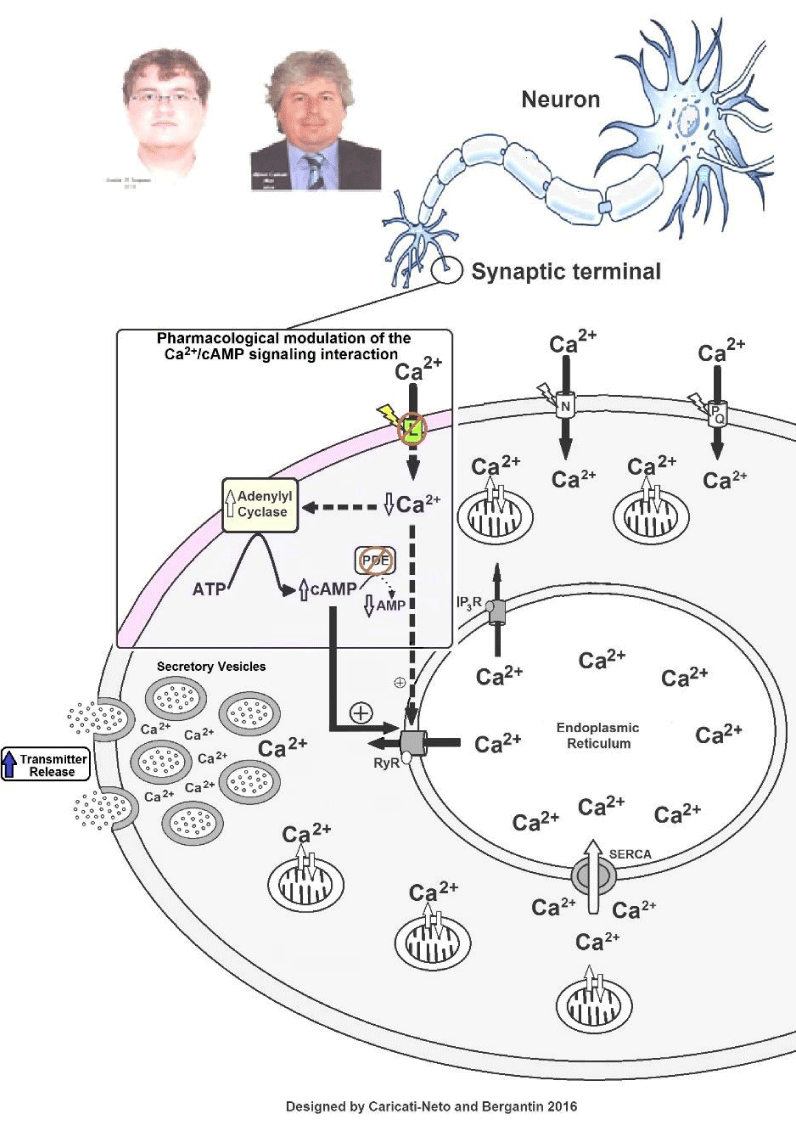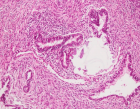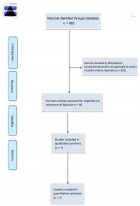Figure 1
Novel Challenges for the Therapeutics of Depression: Pharmacological Modulation of Interaction between the Intracellular Signaling Pathways Mediated by Ca2+ and cAMP
Afonso Caricati-Neto and Leandro Bueno Bergantin*
Published: 30 January, 2017 | Volume 1 - Issue 1 | Pages: 001-006

Figure 1:
Role of Ca2+/cAMP signaling interaction in the neurotransmission. In studies published in 2013, 2015 and 2016 (Caricati-Neto et al. 2015; Bergantin et al. 2013 2015 and 2016 a,b,c,d), we discovered that the paradoxical hyperactivity of sympathetic neurons produced by L-type CCBs results of its interference on the Ca2+/cAMP signaling interaction involved in the neurotransmitter release. The pharmacological manipulation of the Ca2+/cAMP interaction by combined use L-type CCBs and cAMP-enhancer compounds could be a new therapeutic strategy for increasing central serotoninergic and monoaminergic neurotransmission in depression. cAMP: cyclic adenosine monophosphate; ATP: adenosine trisphosphate; L-, N-, P/Q-type Ca2+ channels, IP3R: Inositol trisphosphate receptor; PDE: phosphodiesterase; RyR: ryanodine receptors; SERCA: sarco-endoplasmic Ca2+-ATPase. In addition, store-operated calcium entry (SOCE) is a ubiquitous Ca2+ entry pathway that is activated in response to depletion of Endoplasmic Reticulum-Ca2+ stores, and critically controls the regulation of physiological functions in cell types.
Read Full Article HTML DOI: 10.29328/journal.jatr.1001001 Cite this Article Read Full Article PDF
More Images
Similar Articles
-
Novel Challenges for the Therapeutics of Depression: Pharmacological Modulation of Interaction between the Intracellular Signaling Pathways Mediated by Ca2+ and cAMPAfonso Caricati-Neto,Leandro Bueno Bergantin*. Novel Challenges for the Therapeutics of Depression: Pharmacological Modulation of Interaction between the Intracellular Signaling Pathways Mediated by Ca2+ and cAMP . . 2017 doi: 10.29328/journal.jatr.1001001; 1: 001-006
-
Psychosocial factors among end-stage kidney disease patients receiving hemodialysis treatment in Kumasi, GhanaThomas Nti Amoako*,Frances Emily Owusu-Ansah. Psychosocial factors among end-stage kidney disease patients receiving hemodialysis treatment in Kumasi, Ghana. . 2021 doi: 10.29328/journal.jatr.1001017; 5: 014-019
-
Drug Rehabilitation Centre-based Survey on Drug Dependence in District Shimla Himachal PradeshKanishka Saini,Palak Sharma,Bhawna Sharma*,Atul Kumar Dubey,Muskan Bhatnoo,Prajkta Thakur,Vanshika Chandel,Ritika Sinha. Drug Rehabilitation Centre-based Survey on Drug Dependence in District Shimla Himachal Pradesh. . 2025 doi: 10.29328/journal.jatr.1001032; 9: 001-006
Recently Viewed
-
Laparoscopic Cholecystectomy: Challenges faced by beginners our perspectiveKunal Chowdhary,Gurinder Kaur,Kapil Sindhu,Muzzafar Zaman*,Aliya Shah,Rohit Dang,Ashish Kumar,Jose John Maiakal,Ashutosh Bawa. Laparoscopic Cholecystectomy: Challenges faced by beginners our perspective. Arch Surg Clin Res. 2018: doi: 10.29328/journal.ascr.1001018; 2: 018-024
-
The Fundamental Role of Dissolved Oxygen Levels in Drinking Water, in the Etiopathogenesis, Prevention, Treatment and Recovery of Cerebral Vascular Events (Stroke)Arturo Solís Herrera*. The Fundamental Role of Dissolved Oxygen Levels in Drinking Water, in the Etiopathogenesis, Prevention, Treatment and Recovery of Cerebral Vascular Events (Stroke). J Nov Physiother Rehabil. 2025: doi: 10.29328/journal.jnpr.1001064; 9: 001-006
-
Gossypiboma due to a retained surgical sponge following abdominal hysterectomy, complicated by intestinal migration and small bowel obstruction- A Case ReportVivek Agrawal,Praroop Gupta*. Gossypiboma due to a retained surgical sponge following abdominal hysterectomy, complicated by intestinal migration and small bowel obstruction- A Case Report. Arch Surg Clin Res. 2018: doi: 10.29328/journal.ascr.1001017; 2: 015-017
-
The Essential Role of Esophagogastroduodenoscopy Prior to bariatric surgeryReza Ebrahimi, Mohammad Kermansaravi, Abdolreza Pazouki*. The Essential Role of Esophagogastroduodenoscopy Prior to bariatric surgery. Arch Surg Clin Res. 2018: doi: 10.29328/journal.ascr.1001016; 2: 013-014
-
Role of Helicobacter pylori in causing repeated Reinfection from Oral cavity in Chronic ProstatitisPankaj Garg*. Role of Helicobacter pylori in causing repeated Reinfection from Oral cavity in Chronic Prostatitis. Arch Surg Clin Res. 2018: doi: 10.29328/journal.ascr.1001014; 2: 001-004
Most Viewed
-
Feasibility study of magnetic sensing for detecting single-neuron action potentialsDenis Tonini,Kai Wu,Renata Saha,Jian-Ping Wang*. Feasibility study of magnetic sensing for detecting single-neuron action potentials. Ann Biomed Sci Eng. 2022 doi: 10.29328/journal.abse.1001018; 6: 019-029
-
Evaluation of In vitro and Ex vivo Models for Studying the Effectiveness of Vaginal Drug Systems in Controlling Microbe Infections: A Systematic ReviewMohammad Hossein Karami*, Majid Abdouss*, Mandana Karami. Evaluation of In vitro and Ex vivo Models for Studying the Effectiveness of Vaginal Drug Systems in Controlling Microbe Infections: A Systematic Review. Clin J Obstet Gynecol. 2023 doi: 10.29328/journal.cjog.1001151; 6: 201-215
-
Prospective Coronavirus Liver Effects: Available KnowledgeAvishek Mandal*. Prospective Coronavirus Liver Effects: Available Knowledge. Ann Clin Gastroenterol Hepatol. 2023 doi: 10.29328/journal.acgh.1001039; 7: 001-010
-
Causal Link between Human Blood Metabolites and Asthma: An Investigation Using Mendelian RandomizationYong-Qing Zhu, Xiao-Yan Meng, Jing-Hua Yang*. Causal Link between Human Blood Metabolites and Asthma: An Investigation Using Mendelian Randomization. Arch Asthma Allergy Immunol. 2023 doi: 10.29328/journal.aaai.1001032; 7: 012-022
-
An algorithm to safely manage oral food challenge in an office-based setting for children with multiple food allergiesNathalie Cottel,Aïcha Dieme,Véronique Orcel,Yannick Chantran,Mélisande Bourgoin-Heck,Jocelyne Just. An algorithm to safely manage oral food challenge in an office-based setting for children with multiple food allergies. Arch Asthma Allergy Immunol. 2021 doi: 10.29328/journal.aaai.1001027; 5: 030-037

HSPI: We're glad you're here. Please click "create a new Query" if you are a new visitor to our website and need further information from us.
If you are already a member of our network and need to keep track of any developments regarding a question you have already submitted, click "take me to my Query."



















































































































































